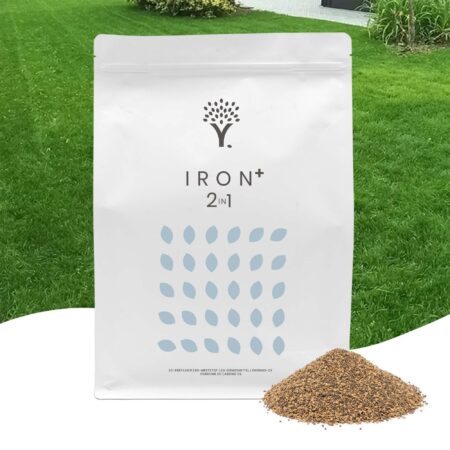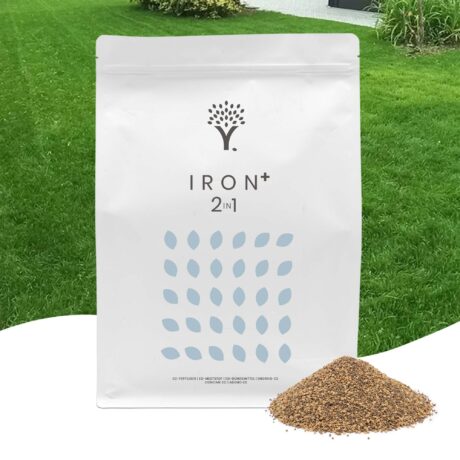Log in or create new account to save this product to your wishlist.

Can You Cut Wet Grass?
To mow or not to mow when the grass is still wet? It's a tricky one, but there are ways to ensure you don't kill your lawn.
🌱 All important maintenance moments for your lawn during the year. Leave your email and we will send you the lawn calendar for free.
Enter your email
Receive the lawn calendar in the mail
Enjoy a green lawn all year round!

- Order by 2PM = shipped today
- 250.000+ satisfied customers!
- 60 day satisfaction guarantee
Your grass is having a seriously bad hair day, but it hasn’t stopped raining for the last couple of weeks. Welcome to the British springtime. Or it could easily be the British summer or autumn, for that matter.
- Why not mow grass when it’s wet?
- Wet grass will tear
- Why mowing wet grass can be dangerous
- Top tips for safely mowing wet grass
- Which is the best lawn mower for wet grass?
- How to maintain your mower after cutting wet grass
- The golden rule of mowing
- Taking care of your lawn in wet weather
- FAQs
- More about garden maintenance?
So, can you cut wet grass?
And while the basic rule is “do not mow wet grass”, sometimes you don’t have a choice.
This article will answer that question, giving some insight into the tricky question of whether to risk mowing your grass when it’s wet.
Ready?
Why not mow grass when it’s wet?
There are several reasons why cutting wet grass is a bad idea.
Principally, your lawn mower isn’t designed to work effectively on wet surfaces. Wet grass flattens quickly, which makes the task of cutting particularly tricky for your mower.
Dry grass stands upright more readily, ensuring you get a nice, clean cut.
Wet grass will tear

Wet grass doesn’t cut as cleanly as dry grass, so rather than slicing through the leaf, the cutting blade tears it. This is bad for your grass because it leaves a larger wound on the leaf, which promotes the drying out and yellowing of the tip.
Wet grass tends to accumulate around your mower’s moving parts, which leads to clogging and poor engine performance. This can lead to overheating — shortening the life of your mower.
Why mowing wet grass can be dangerous
Firstly, your mower’s wheels can leave marks and potholes in wet grass, leading to irregular growth and damage to the turf.
However, the main reason mowing wet grass is hazardous is that it increases the chances of slipping or falling, especially when mowing on slopes.
And don’t forget; you’re in control of a fairly powerful machine.
If you have to mow wet grass, be extra careful, and apply appropriate safety measures to avoid injury. And be extra cautious when handling an electric mower because water and electricity are a dangerous combination.
Top tips for safely mowing wet grass

It’s always preferable to wait until the grass has dried out. But if rain is forecast, mow before the shower if you can. This kills two birds with one stone because the rain will water your lawn straight after mowing, which promotes regrowth and recovery.
However:
If there’s no other option than mowing when wet, follow these safety precautions:
- Leave the grass until it’s dried out as much as possible. This reduces the risk of damaging the grass and your mower.
- Set the cutting blades as high as they’ll go. This minimises the impact on your grass plants and will prevent clogging your mower.
- Clean your mower immediately after cutting. Switch off the power, and scrape the accumulated grass from the underside of the machine.
- Rake away clippings. Wet clippings are heavy and will suffocate your grass plants if you leave them on top of your lawn.
- Use slow, straight lines. This prevents irregular growth.
Never mow WHILE it’s raining, and avoid sharp turns. And try to walk on the wet grass as little as possible to prevent soil compaction.
Which is the best lawn mower for wet grass?
A self-propelled mower reduces pressure on the lawn, so you could opt for a robot mower, which is usually both relatively lightweight and precise.
Choose a mower with an adjustable cutting height, and raise it to its highest level to protect your grass plants if mowing wet.
How to maintain your mower after cutting wet grass
Ensure you clean the underside of your mower thoroughly after cutting damp grass, carefully removing grass stuck to the cutting blades. Mind your fingers!
Wet grass sticks to the undercarriage and the wheels, so take extra care to remove all the stuck-on waste.
This is an excellent opportunity to check that your cutting blades are sharp. If they appear blunt, get them sharpened. Cutting your grass with dull blades will damage your lawn, and it’s likely to turn your grass yellow or brown at the tips after mowing.
So, if you’ve noticed the tips of your grass go yellow after cutting, get your blades sharpened.
The golden rule of mowing
And remember: never cut more than ⅓ of the grass blade’s length. Cutting your grass too short results in poor growth and susceptibility to disease and weeds.
Your grass plants store their energy in the leaves, so if you chop too much away, you’ll starve the plant of its nutrients.
Taking care of your lawn in wet weather
There are several lawn care products you can use to protect your lawn and keep it healthy during wet conditions.
Grass seed
if you find that your lawn doesn’t recover well after wet mowing, sow new grass seed to help repair the damage and promote healthy growth.
Ensure you choose a seed suitable for your garden’s conditions, and sow in the autumn or spring for best results.
If you’re unsure how to decide which lawn seed would be best for your garden, check out our expert guide: Is your Grass Type Right for your Garden?
Soil improvers
Soil improvers, such as compost and organic fertilisers, can help maintain a healthy soil structure.
MOOWY offers an extensive range of high-quality lawn fertilisers to suit every lawn and garden type.
If you’re unsure about how to fertilise your lawn, check out our expert guide to fertilising your turf.
Anti-fungal agents
If you suffer from mould, you can use an anti-fungal agent to prevent mould growth. Apply according to the packet’s instructions.
-
Spring Boost Lawn Fertiliser
Out of stock
12.99- Order by 2PM = shipped today
- 250.000+ satisfied customers!
- 60 day satisfaction guarantee
-
Iron Sulphate Lawn Fertiliser
Out of stock
14.99- Order by 2PM = shipped today
- 250.000+ satisfied customers!
- 60 day satisfaction guarantee
-
BestsellerAll-Round Lawn Fertiliser
Out of stock
12.99- Order by 2PM = shipped today
- 250.000+ satisfied customers!
- 60 day satisfaction guarantee
FAQs
Ideally, no. But if you really have to, use the highest blade setting and ensure you collect all the clippings. Avoid walking on wet grass too much as it sticks to the ground and won’t cut. But, ideally, wait until your lawn has dried out before mowing.
Mowing a wet lawn can damage your lawn and your mower. So, wait until the grass blades are dry before cutting. Remember, water and electricity are not a good mix, and wet lawns pose slip hazards, especially on slopes.
Ideally, wait until the lawn is dry before you mow. If you cut at the mower’s highest setting you should be OK. However, if there’s signs of damage, fertilise well, overseed any dying patches, and wait for a couple of weeks before mowing again. Let you lawn recover naturally.
More about garden maintenance?
We hope you’ve got all the info you need to help you decide whether to mow your lawn when it’s wet. But if you have any questions, you can always contact us. And we’ll be delighted to help.
And don’t forget to check out our comprehensive Help & Advice section for everything about lawns and growing plants in your garden.
Thanks for reading.
-
The Best Lawn Mower Maintenance Tips & ChecklistProper lawn mower maintenance is crucial to extend its lifespan, and you'll also save on repair costs. Learn how to keep this helper performing at its best.Read more
-
The Pros and Cons of a Robot LawnmowerNot all robots are out to take over the planet (or steal our jobs). Some robots are here to take the hassle out of mowing. Find out the pros and cons of these convenient gadgets.Read more
-
How to Sharpen Your Lawn Mower Blades: An Ultimate GuideCutting your lawn with blunt blades leaves your grass plants open to diseases and pets. Sharpening lawn mower blades is a relatively simple DIY task. Find out how.Read more
-
Lawn Mowing: Why, When & How Often You Should Do ItWhen and how often should you mow the lawn? What is the ideal cutting height? Which mower should you use? Find answers to these questions and more here.Read more
Leave a comment
Your answer will be displayed on the site and the interested party will be notified by email.
Leave a comment
Have a question or want to share your experience? Leave us a comment.

- Order by 2PM = shipped today
- 250.000+ satisfied customers!
- 60 day satisfaction guarantee

- Order by 2PM = shipped today
- 250.000+ satisfied customers!
- 60 day satisfaction guarantee

🌱 All important maintenance moments for your lawn during the year. Leave your email and we will send you the lawn calendar for free.
Enter your email
Receive the lawn calendar in the mail
Enjoy a green lawn all year round!
























Comments (0)
There are no comments yet. Well then, what are you waiting for to
Be the first to write your comment!inaugurate this pretty page?
Do you have some comments?